Haworthia
| Haworthia | |
|---|---|
 | |
| Haworthia attenuata | |
| Scientific classification | |
| Kingdom: | Plantae |
| Clade: | Angiosperms |
| Clade: | Monocots |
| Order: | Asparagales |
| Family: | Asphodelaceae |
| Subfamily: | Asphodeloideae |
| Genus: | Haworthia Duval |
| Synonyms[1] | |

Haworthia is a large genus of small succulent plants endemic to Southern Africa (Mozambique, Namibia, Lesotho, Swaziland, South Africa).[1]
Like the Aloes, they are members of the subfamily Asphodeloideae and they generally resemble miniature aloes, except in their flowers, which are distinctive in appearance. Horticulturally they are popular garden and container plants.
Description and characteristics
Haworthias are small succulent plants, forming rosettes of leaves from 3 cm (1.2 in) to exceptionally 30 cm (12 in) in diameter, depending on the species. These rosettes are usually stemless but in some species stems reach up to 50 cm (20 in). The inflorescences of some species may exceed 40 cm (16 in) in height. The plants can grow solitary or can be clump-forming. Most species have firm, tough, fleshy leaves, usually dark green in color, whereas others are softer and contain leaf windows with translucent panels through which sunlight can reach internal photosynthetic tissues. Their flowers are small, white and very similar between species. But their leaves show wide variations even within one species.
Distribution
Most species are endemic to South Africa, with the greatest species diversity occurring in the south-western Cape. Some species do however extend into neighbouring territories, in Swaziland, southern Namibia and southern Mozambique (Maputaland).
Naming and taxonomy
Haworthia is a genus within the family Asphodelaceae, subfamily Asphodeloideae. The genus is named after the botanist Adrian Hardy Haworth. B. Bayer recognized approximately 60 species in a review of the genus in 2012, whereas other taxonomists are very much less conservative. Related genera are Aloe, Gasteria and Astroloba and intergeneric hybrids are known. [2][3]
Subdivisions
The classification of the flowering plant subfamily Asphodeloideae is weak, and concepts of the genera are not well substantiated. Haworthia is similarly a weakly contrived genus. Because of their horticultural interest, its taxonomy has been dominated by amateur collectors, and the literature is rife with misunderstanding of what the taxa actually are or should be. Currently, this relatively loose genus is subdivided into three very distinct groups, traditionally labelled as sub-genera:
- Haworthia, c. 42 spp. Typically green, stemless, soft-leaved species
- Hexangulares (or genus Haworthiopsis, G.D.Rowley), 18 spp. Hard-leaved and sometimes stemmed species
- Robustipedunculares (or genus Tulista, Raf.), 4 spp. Robust, hard-leaved species
Recent phylogenetic studies have demonstrated that the three sub-genera are actually relatively unrelated (Hexangulares was shown to be a sister-group of genus Gasteria, Robustipedunculares more closely related to genus Astroloba, and Haworthia as an out-group related to Aloe). In recognition of the polyphyletic nature of the genus, it has been proposed that Hexangulares and Robustipedunculares be moved into new separate genera ("Haworthiopsis" and "Tulista" respectively).
Botanists had long noticed differences in the flowers the three sub-genera, but had previously considered those differences to be inconsequential, although the differences between species in the same subgenus definitely are. The roots, leaves and rosettes do demonstrate some generic differences while wide variations occur even within one species.[4][5]
Species
There are about 151 accepted species of Haworthia listed in the Plant List site produced in collaboration between the Royal Botanic Gardens, Kew and Missouri Botanical Garden. However, the actual number and identification of the species is not established; there are over forty species listed as "unresolved" for lack of sufficient information, and the full list reflects the difficulties of Haworthia taxonomy; it includes varieties and synonyms to a total of 966, even though it excludes various garden hybrids and cultivars.[6] The following list includes only the fully accepted species in the Plant List.
- Haworthia agnis Battista
- Haworthia akaonii M.Hayashi
- Haworthia albispina M.Hayashi
- Haworthia amethysta M.Hayashi
- Haworthia angustifolia Haw.
- Haworthia ao-onii M.Hayashi
- Haworthia aquamarina M.Hayashi
- Haworthia arabesqua M.Hayashi
- Haworthia arachnoidea (L.) Duval
- Haworthia aristata Haw.
- Haworthia attenuata (Haw.) Haw.
- Haworthia azurea M.Hayashi
- Haworthia bathylis M.Hayashi
- Haworthia bayeri J.D.Venter & S.A.Hammer
- Haworthia bella M.Hayashi
- Haworthia blackburniae W.F.Barker
- Haworthia bolusii Baker
- Haworthia borealis M.Hayashi
- Haworthia breueri M.Hayashi
- Haworthia bronkhorstii M.Hayashi
- Haworthia bruynsii M.B.Bayer
- Haworthia caerulea M.Hayashi & Breuer
- Haworthia caesia M.Hayashi
- Haworthia calva M.Hayashi
- Haworthia candida M.Hayashi
- Haworthia capillaris M.Hayashi
- Haworthia chloracantha Haw.
- Haworthia coarctata Haw.
- Haworthia compacta (Triebner) Breuer
- Haworthia cooperi Baker
- Haworthia crausii M.Hayashi
- Haworthia crinita M.Hayashi
- Haworthia crystallina M.Hayashi
- Haworthia cummingii Breuer & M.Hayashi
- Haworthia cymbiformis (Haw.) Duval
- Haworthia davidii (Breuer) M.Hayashi & Breuer
- Haworthia decipiens Poelln.
- Haworthia devriesii Breuer
- Haworthia diaphana M.Hayashi
- Haworthia diversicolor (Triebner & Poelln.) M.Hayashi
- Haworthia elizeae Breuer
- Haworthia emelyae Poelln.
- Haworthia emeralda M.Hayashi
- Haworthia eminens M.Hayashi
- Haworthia enigma M.Hayashi
- Haworthia esterhuizenii M.Hayashi
- Haworthia exilis M.Hayashi
- Haworthia fasciata (Willd.) Haw.
- Haworthia flavida M.Hayashi
- Haworthia floccosa M.Hayashi
- Haworthia florens M.Hayashi
- Haworthia floribunda Poelln.
- Haworthia fluffa M.Hayashi
- Haworthia foliosa Haw.
- Haworthia fukuyae M.Hayashi
- Haworthia glabrata (Salm-Dyck) Baker
- Haworthia glauca Baker
- Haworthia gracilis Poelln.
- Haworthia groenewaldii Breuer
- Haworthia hamata M.Hayashi
- Haworthia harryi M.Hayashi
- Haworthia hastata M.Hayashi
- Haworthia hayashii M.Hayashi
- Haworthia heidelbergensis G.G.Sm.
- Haworthia herbacea (Mill.) Stearn
- Haworthia hisui M.Hayashi
- Haworthia indigoa M.Hayashi
- Haworthia integra Poelln.
- Haworthia jadea M.Hayashi
- Haworthia jansenvillensis Breuer
- Haworthia jeffreis M.Hayashi
- Haworthia kemari M.Hayashi
- Haworthia kingiana Poelln.
- Haworthia koelmaniorum Oberm. & D.S.Hardy
- Haworthia lachnosa M.Hayashi
- Haworthia laeta M.Hayashi
- Haworthia latericia M.Hayashi
- Haworthia ligulata M.Hayashi
- Haworthia limifolia Marloth
- Haworthia lockwoodii Archibald
- Haworthia longiana Poelln.
- Haworthia maculata (Poelln.) M.B.Bayer
- Haworthia magnifica Poelln.
- Haworthia maraisii Poelln.
- Haworthia marginata (Lam.) Stearn
- Haworthia marmorata M.Hayashi
- Haworthia marumiana Uitewaal
- Haworthia marxii Gildenh.
- Haworthia maxima (L.) Duval
- Haworthia minima (Ait.) Haw.
- Haworthia minor (Aiton) Duval
- Haworthia mirabilis (Haw.) Haw.
- Haworthia mollis M.Hayashi
- Haworthia monticola Fourc.
- Haworthia mortonii Breuer
- Haworthia mucronata Haw.
- Haworthia mutica Haw.
- Haworthia nigra (Haw.) Baker
- Haworthia nigrata M.Hayashi
- Haworthia nortieri G.G.Sm.
- Haworthia oculata M.Hayashi
- Haworthia odetteae Breuer
- Haworthia ohkuwae M.Hayashi
- Haworthia opalina M.Hayashi
- Haworthia outeniquensis M.B.Bayer
- Haworthia pallidifolia (G.G.Sm.) M.Hayashi
- Haworthia parksiana Poelln.
- Haworthia pectinis M.Hayashi
- Haworthia pilosa M.Hayashi
- Haworthia pubescens M.B.Bayer
- Haworthia pulchella M.B.Bayer
- Haworthia pungens M.B.Bayer
- Haworthia pusilla M.Hayashi
- Haworthia pygmaea Poelln.
- Haworthia regalis M.Hayashi
- Haworthia regina M.Hayashi
- Haworthia reinwardtii (Salm-Dyck) Haw.
- Haworthia reticulata (Haw.) Haw.
- Haworthia retusa (L.) Duval
- Haworthia salina (Poelln.) M.Hayashi
- Haworthia sapphaia M.Hayashi
- Haworthia scabra Haw.
- Haworthia schoemanii M.Hayashi
- Haworthia scottii Breuer
- Haworthia semiviva (Poelln.) M.B.Bayer
- Haworthia serrata M.B.Bayer
- Haworthia sordida Haw.
- Haworthia sparsa M.Hayashi
- Haworthia springbokvlakensis C.L.Scott
- Haworthia subhamata M.Hayashi
- Haworthia subularis M.Hayashi
- Haworthia succinea M.Hayashi
- Haworthia tarkasia M.Hayashi
- Haworthia tauteae Archibald
- Haworthia teres M.Hayashi
- Haworthia tradouwensis Breuer
- Haworthia tretyrensis Breuer
- Haworthia tricolor (Breuer) M.Hayashi
- Haworthia truncata Schönland
- Haworthia truterorum Breuer & Marx
- Haworthia turgida Haw.
- Haworthia variegata L.Bolus
- Haworthia veltina M.Hayashi
- Haworthia venetia M.Hayashi
- Haworthia venosa (Lam.) Haw.
- Haworthia villosa M.Hayashi
- Haworthia violacea M.Hayashi
- Haworthia viscosa (L.) Haw.
- Haworthia vlokii M.B.Bayer
- Haworthia wittebergensis W.F.Barker
- Haworthia zantneriana Poelln.
- Haworthia zenigata M.Hayashi
.jpg)
Cultivation
There is widespread special collector interest, and some species such as Haworthia attenuata and Haworthia cymbiformis, are fairly common house and garden plants.
Almost all Haworthia species are naturally adapted for semi-shade conditions (in habitat they tend to grow under bushes or rock overhands) and they are therefore healthiest in shade or semi-shade. Some species like Haworthia maxima and Haworthia truncata can be adapted to tolerate full-sun however.
All Haworthia species favour extremely well-drained soil (in habitat they tend to grow in poor sands, in rocky areas). Watering depends on the species (winter or summer rainfall) but most of the common species are tolerant of a variety of watering routines. Rarer species may have more specific requirements.[7]
Haworthia species reproduce both through seed and through budding, or offsets. Certain species or clones may be more successful or rapid in offset production, and these pups are easily removed to yield new plants once a substantial root system has developed on the offshoot. Less reliably, the plants may also be propagated through leaf cuttings, and in some instances, through tissue culture.
Gallery for identification
Haworthia
 Haworthia arachnoidea has numerous dark-green leaves, which have no translucent tips and bear a dense hairy web of spines.
Haworthia arachnoidea has numerous dark-green leaves, which have no translucent tips and bear a dense hairy web of spines. Haworthia nortieri, from the far north-west of the Western Cape, has opaque leaves, covered in oval, pellucid spots.
Haworthia nortieri, from the far north-west of the Western Cape, has opaque leaves, covered in oval, pellucid spots. Haworthia maculata, showing distinctive red-purple, spotted, normally turgid leaves, with tiny bristles on margins & keels.
Haworthia maculata, showing distinctive red-purple, spotted, normally turgid leaves, with tiny bristles on margins & keels. The highly proliferous Haworthia reticulata bears tiny teeth and a reticulated pattern on its leaves.
The highly proliferous Haworthia reticulata bears tiny teeth and a reticulated pattern on its leaves. Haworthia herbacea, showing distinctive yellow-green ("herbacea") colour, and spined margins & keels.
Haworthia herbacea, showing distinctive yellow-green ("herbacea") colour, and spined margins & keels. Haworthia pubescens co-occurs with H.herbacea but is very finely "pubescent" (covered in velvety fur)
Haworthia pubescens co-occurs with H.herbacea but is very finely "pubescent" (covered in velvety fur) Haworthia floribunda has relatively few dark, slender, twisted leaves with rounded ends.
Haworthia floribunda has relatively few dark, slender, twisted leaves with rounded ends. Haworthia chloracantha forms clumps with slender, curved, yellow-green leaves
Haworthia chloracantha forms clumps with slender, curved, yellow-green leaves Haworthia variegata has thin, straight, erect leaves, with variegated spined margins.
Haworthia variegata has thin, straight, erect leaves, with variegated spined margins. Haworthia parksiana, the smallest Haworthia species.
Haworthia parksiana, the smallest Haworthia species. Haworthia maraisii is a tiny, dark-coloured haworthia, with bristled, retused leaves.
Haworthia maraisii is a tiny, dark-coloured haworthia, with bristled, retused leaves.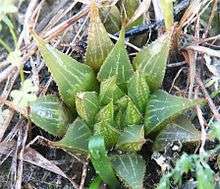 Haworthia mirabilis has sharp-pointed, translucent leaf faces with marginal spines
Haworthia mirabilis has sharp-pointed, translucent leaf faces with marginal spines Haworthia mirabilis var. badia has reddish-brown, attenuate leaves
Haworthia mirabilis var. badia has reddish-brown, attenuate leaves Haworthia heidelbergensis possibly a form of H. mirabilis, with long, thin, bristle-tipped leaves, that are more outward spreading.
Haworthia heidelbergensis possibly a form of H. mirabilis, with long, thin, bristle-tipped leaves, that are more outward spreading.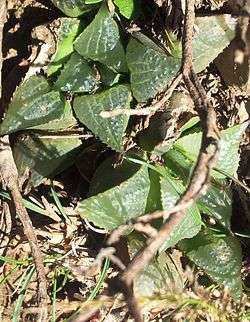 Haworthia magnifica is sometimes considered to be a form of H. mirabilis. It is distinguished by its flowers, but usually has dark, lined, triangular, scabrid leaf-faces.
Haworthia magnifica is sometimes considered to be a form of H. mirabilis. It is distinguished by its flowers, but usually has dark, lined, triangular, scabrid leaf-faces.- Haworthia magnifica var. splendens is a particularly ornate variety with flecked leaves, prized by horticulturalists as "Haworthia splendens".
 Haworthia magnifica var. acuminata has a lighter colour and more pointed, "acuminate" leaves
Haworthia magnifica var. acuminata has a lighter colour and more pointed, "acuminate" leaves Haworthia magnifica var. atrofusca is a very dark, reddish-brown, rough-surfaced variety
Haworthia magnifica var. atrofusca is a very dark, reddish-brown, rough-surfaced variety Haworthia turgida is a compact, clumping, retuse haworthia, with swollen, "turgid", light-green leaves
Haworthia turgida is a compact, clumping, retuse haworthia, with swollen, "turgid", light-green leaves Haworthia mutica has one or two lines and a pale, cloudy, mat surface on its compact, slightly rounded ("mutica") leaves
Haworthia mutica has one or two lines and a pale, cloudy, mat surface on its compact, slightly rounded ("mutica") leaves Haworthia groenwaldii is sometimes considered a smaller form of H.mutica, but has spots and a different flowering time
Haworthia groenwaldii is sometimes considered a smaller form of H.mutica, but has spots and a different flowering time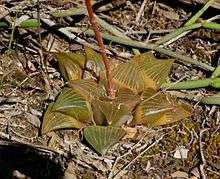 Haworthia retusa has a recognisable shiny leaf-face on its retuse leaves, and a light green colour
Haworthia retusa has a recognisable shiny leaf-face on its retuse leaves, and a light green colour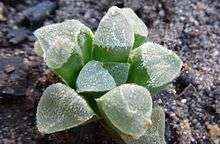 Haworthia pygmaea has flat, rough, scabrous or papillate leaf surfaces
Haworthia pygmaea has flat, rough, scabrous or papillate leaf surfaces "agenteo-maculosa" is a smoother variety of Haworthia pygmaea with silver spots ("argenteo maculosa")
"agenteo-maculosa" is a smoother variety of Haworthia pygmaea with silver spots ("argenteo maculosa") Haworthia emelyae/picta has compact, bulging leaves which are often pink-flecked.
Haworthia emelyae/picta has compact, bulging leaves which are often pink-flecked. Haworthia bayeri has dark leaves with slightly rounded leaf tips.
Haworthia bayeri has dark leaves with slightly rounded leaf tips.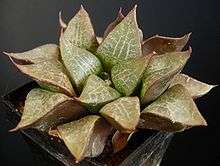 Haworthia emelyae var. comptoniana is a large, lighter coloured form, with a clear reticulated pattern on the broad leaf faces
Haworthia emelyae var. comptoniana is a large, lighter coloured form, with a clear reticulated pattern on the broad leaf faces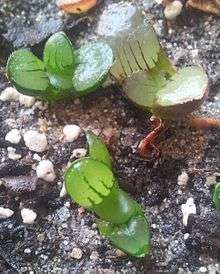 Haworthia springbokvlakensis has round, bulging, translucent leaf faces
Haworthia springbokvlakensis has round, bulging, translucent leaf faces- Haworthia truncata ("Horse's teeth")
 Haworthia wittebergensis showing its distinctive thin bristle-like leaves
Haworthia wittebergensis showing its distinctive thin bristle-like leaves.jpg) Haworthia semivivadrys its leaves into a papery sheath in the heat of summer.
Haworthia semivivadrys its leaves into a papery sheath in the heat of summer._(4875874684).jpg) Haworthia lockwoodii drys its leaves into a papery sheath in the heat of summer.
Haworthia lockwoodii drys its leaves into a papery sheath in the heat of summer. Haworthia marumiana var. redii
Haworthia marumiana var. redii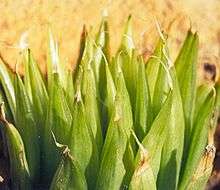 Haworthia mucronata has translucent margins and keels on its soft, pointed ("mucronate") leaves.
Haworthia mucronata has translucent margins and keels on its soft, pointed ("mucronate") leaves.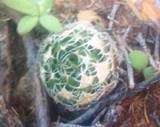 Haworthia decipiens has light green, wide, flat, semi-translucent leaves, that have prodigious bristles on the margins (less so on the bottom leaf faces)
Haworthia decipiens has light green, wide, flat, semi-translucent leaves, that have prodigious bristles on the margins (less so on the bottom leaf faces)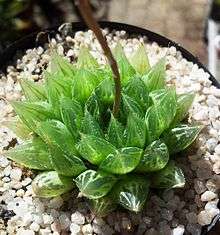 Haworthia cooperi (showing translucent "window" panels at the tips of its leaves)
Haworthia cooperi (showing translucent "window" panels at the tips of its leaves)- An extreme rounded form of Haworthia cooperi
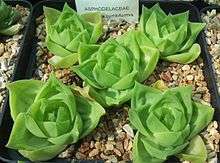 Haworthia cymbiformis has light green, even-coloured, boat-shaped leaves ("cymbiformis" = "boat shaped")
Haworthia cymbiformis has light green, even-coloured, boat-shaped leaves ("cymbiformis" = "boat shaped") Haworthia blackburneae is a thin, grass-like species
Haworthia blackburneae is a thin, grass-like species
Hexangulares (Haworthiopsis)
Coarctatae
Stemmed (caulescent) species:
 Haworthia attenuata, probably the most commonly cultivated haworthia, has long attenuate leaves
Haworthia attenuata, probably the most commonly cultivated haworthia, has long attenuate leaves.jpg) The "glabrata" form of Haworthia attenuata has a more even brown colour, mostly without tubercles ("glabrous")
The "glabrata" form of Haworthia attenuata has a more even brown colour, mostly without tubercles ("glabrous")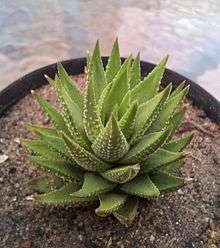 Haworthia fasciata has a lighter colour, and fibrous leaves with glabrous inner surfaces
Haworthia fasciata has a lighter colour, and fibrous leaves with glabrous inner surfaces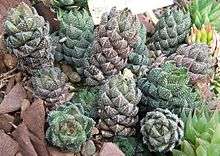 Haworthia coarctata has small, smooth, rounded tubercles
Haworthia coarctata has small, smooth, rounded tubercles Haworthia reinwardtii has larger, flatter, whiter tubercles, and is often more slender than H.coarctata.
Haworthia reinwardtii has larger, flatter, whiter tubercles, and is often more slender than H.coarctata. Haworthia glauca has a blue ("glaucous") colour
Haworthia glauca has a blue ("glaucous") colour
Trifariae
Species with a three-way ("trifarious") leaf arrangement
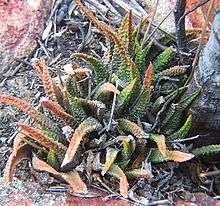 Haworthia scabra is a stemless species with a rough scabrid leaf surface
Haworthia scabra is a stemless species with a rough scabrid leaf surface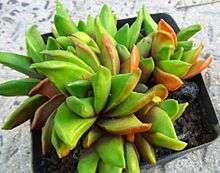 Haworthia starkiana is a lighter, glabrous form of H.scabra
Haworthia starkiana is a lighter, glabrous form of H.scabra Haworthia nigra has a dark colour and concolourous tubercles
Haworthia nigra has a dark colour and concolourous tubercles Haworthia viscosa has a lighter brown mat surface, and no tubercles
Haworthia viscosa has a lighter brown mat surface, and no tubercles Haworthia pungens has hard, sharp ("pungent") leaf tips
Haworthia pungens has hard, sharp ("pungent") leaf tips Haworthia sordida has dark, dusty ("sordid") leaves with rounded tips
Haworthia sordida has dark, dusty ("sordid") leaves with rounded tips Haworthia longiana has long, thin, elongated leaves.
Haworthia longiana has long, thin, elongated leaves.
Venosae
Species with splayed leaves bearing vein-markings ("venose") on the upper leaf surface
 Haworthia venosa has visible veins ("venosa") on its upper leaf surfaces
Haworthia venosa has visible veins ("venosa") on its upper leaf surfaces The tessellata subspecies of Haworthia venosa has more ornate, tessellated markings on its leaf-faces
The tessellata subspecies of Haworthia venosa has more ornate, tessellated markings on its leaf-faces The granulata subspecies of Haworthia venosa has compact little stems and granulate leaves
The granulata subspecies of Haworthia venosa has compact little stems and granulate leaves Haworthia limifolia has splayed leaves usually with raised lateral lines or wrinkles on the leaf surfaces
Haworthia limifolia has splayed leaves usually with raised lateral lines or wrinkles on the leaf surfaces Haworthia koelmaniorum is an unusual species from far to the north of South Africa, which has scabrid, dark brown opaque leaves
Haworthia koelmaniorum is an unusual species from far to the north of South Africa, which has scabrid, dark brown opaque leaves Haworthia bruynsii has evolved a retuse shape, but is nonetheless a member of the hexangulares.
Haworthia bruynsii has evolved a retuse shape, but is nonetheless a member of the hexangulares.
Robustipedunculares (Tulista)
 Haworthia marginata has a mostly glabrous leaf surface, with clear white margins and keels.
Haworthia marginata has a mostly glabrous leaf surface, with clear white margins and keels.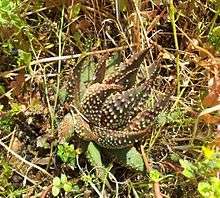 Haworthia maxima is the largest haworthia, usually solitary, and heavily tubercled, with white & yellow-brown flowers
Haworthia maxima is the largest haworthia, usually solitary, and heavily tubercled, with white & yellow-brown flowers Haworthia minima is smaller and more proliferous/clumping than H.maxima, with more numerous, white, rounded tubercles and pink-white flowers.
Haworthia minima is smaller and more proliferous/clumping than H.maxima, with more numerous, white, rounded tubercles and pink-white flowers. Haworthia kingiana has a more yellow-green colour, and relatively fewer tubercles which are rounded and more flat to the surface of the leaf.
Haworthia kingiana has a more yellow-green colour, and relatively fewer tubercles which are rounded and more flat to the surface of the leaf.
References
- 1 2 Kew World Checklist of Selected Plant Families
- ↑ Stevens, P.F., Angiosperm Phylogeny Website: Asparagales: Asphodeloideae
- ↑ Bayer, B. (2012), Haworthia Update - Essays on Haworthia Vol. 7, Part 1.
- ↑ Manning, John; Boatwright, James S.; Daru, Barnabas H.; Maurin, Olivier; van der Bank, Michelle. A Molecular Phylogeny and Generic Classification of Asphodelaceae subfamily Alooideae: A Final Resolution of the Prickly Issue of Polyphyly in the Alooids? Systematic Botany, Volume 39, Number 1, March 2014, pp. 55-74
- ↑ http://www.haworthia.org.uk/haworthia.htm
- ↑ The Plant List (2010). Version 1. Published on the Internet; http://www.theplantlist.org/ (accessed December 2012).
- ↑ The cultivation of different Haworthia species
External links
| Wikimedia Commons has media related to Haworthia. |
- Haworthia (Ingo Breuer)
- Haworthia (Jakub Jilemicky)
- Asphodelaceae Anonymous (Lawrence Loucka)
- Haworthia Society
- Haworthia Updates (M.B.Bayer)